Every year, gardeners - daccias try to master the growing of new colors on their summer cottages. Among the new and modern cultures, which relatively recently began to disembark on the territory of Russia, the Darmera is a special place. This plant has a very beautiful appearance and rich history, due to which today everything becomes more likely to be used in floral design. More about the features of Darmera Thyroid, as well as on landing and leaving for this culture - let's tell later in the article.
Darmer thyroid. Culture characteristics
Darmer's flower shit belongs to the family of camneur. The plant has a few more names - the shit-shaped stamping (such a name culture gave John Tori), Pelthifillaum thyroid (this name flower received from the scientist A. Kellog). The last name was obtained due to the external characteristics of the plant, namely the thyroid form of the sheet. The name consists of a set of Greek words "Pelte" - shield and "PHYLLON" - leaflet.
The main characteristics of the culture are as follows:
- Most often, this culture can be found in the United States, although, recently, it often began to grow in some regions of Russia, the Caucasus.
- The natural habitat of culture is rocky slopes and mountain plains. Darmer can be found even high in the mountains (at an altitude of 1600-1800 m.).
- Prefers a plant grow in fertile soils enriched with humus. The acidity of the soil for disembarking Darmera should be slightly elevated. In addition, the land must be well moisturized and drained so that the surplus of moisture is not stuffed.
- In order to increase the soil moisture, it is possible to plant a culture near any reservoir (even artificial).
- A distinctive feature of culture can be considered that it feels perfectly not only on solar pools, but also in a half. Therefore, you can land a darmer on areas located in the shade of trees.
- The plant has an rootary in the form of a rod. During the cultivation of Darmera, its root system will acquire a multitude of processes. However, the central root remains in the form of a massive and large rod.
- The leaflets of the culture have a rounded shape (visually something resembling the shape of the shield, from which the plant and obtained its name). The size of the sheet plate is reached 800-900 mm.
- Plant leaflets have long and thin stiffs. Their sizes reach 1.5 m.
- Flowers culture with small flowers having a gentle pink shade. Flowers are collected in the inflorescence of an umbrella.
- Culture bloom is observed mainly in the spring. This plant is different from many others, whose flowering peak falls on the summer months.
- The shoots on which plants are located, can reach one and a half meters.
Rules of growing dammer thyroid
Since Darmer's thyroid is relatively recently started to cultivate in Russia, not all flower dackets have completely mastered the knowledge of the entire technology of cultivation of this culture. However, the following can be attributed to the basic rules and conditions of cultivation of this plant:
- As mentioned above, this culture is unpretentious to lighting. The plant feels perfectly both in the sunny plot and in the half, and even in the shade. Therefore, the thyroid darome can be planted in glades hiding under crowns of large deciduous trees. However, the optimal conditions will still be areas with diffused lights located near deciduous shrubs. In this case, early in the spring, when the plant especially acutely needs sunlight, there will be no obstacles for this, because at this time of the year, deciduous shrubs are not yet covered with foliage and therefore, through their branches, the sun's rays go through their branches. In the summer, on the contrary, when the leaves appear on the shoots, the Darmer thyroid will be protected from intensive solar radiation.
- The plant grows well on moisturized soils. Therefore, the beds where this culture is planted, should be regularly water. At the same time, the soil should be well drained, otherwise the moisture stagnation will lead to the formation of foci of rot on the root system of Darmera.
- The land on which the plant is planned to plant should be weak or neutral.
- In order to increase the fertility of the soil on a plot prepared for planting culture, it should be complemented with fertilizers. For this, mineral and organic feeding are suitable.
Landing Darmera Shimoids
Plant multiplies in several ways:
- By the generative method (with the help of seeds). Landing material Darmera thyroid can be bought in any flower shop or assemble it on its summer cottage.
- Vegetative method (using the division of the bush).
In the second way, the plant grows most often. To do this, do the following:
- Pre-prepared the root of culture, divide it into several parts.
- Then the planting material is treated with a solution of fungicide.
- Next landing parts of root into containers with soil.
- In the fall, divided rhizomes are transplanted to the site. The first bloom of the plant with this method of reproduction can be observed already next in spring.
If the plant is planted with seeds, then you need to do the following:
- First of all, plant seeds must pass preliminary training. For this, they are placed in a wet and cool place (for example, on a balcony or refrigerator). And kept at a temperature of +5 degrees for 1 month.
- After the seeds go through the stratification procedure, they are planted into the container with the soil. There they are as long as the first sprouts will be processed.
- When sprouts appear, the darmera transplant into open ground. The flowering of culture lined with a generative method is observed only for the 2nd year after landing.
Caring for Darmera Thyroid
Caring for dammer thyroid lies in the following:
- The area on which the culture grows should be timely water. In this case, it is impossible to allow moisture stagnation.
- The soil on the site must be regularly loosened.
- The soil should be fertilized. For this, mineral and organic fertilizers are suitable (for example, humus, litter, manure). If the feeders are used in liquid form, they should be made 1 time in 3-4 weeks. Dry mixes are introduced into the soil only in March.
- It should be remembered that the Darmer thyroid is not a winter-hard-resistant plant, so the seedlings need to be wrapped in the onset of the first cold. Dry foliage, sawdust and straw are perfectly suitable as shelter.
Diseases and pests Darmera thyroid
Like most flower plants, Darmera thyroid is subject to various diseases and the action of pests, although not to such an extent as other flowers. With proper care, this plant practically does not suffer, but errors were made in watering or soil preparation, the disease can trigger imperceptibly and destroy not only one plant, but also the whole flower. The most frequently encountered diseases that damage the damner of the thyroid are:
- Fusariosis. This is a fungal disease that affects the plant regardless of age. Basically, the activity of the mushroom, which causes fuzariosis, is precipitated for the period of bootonization and flowering Darmera. Settling in the roots, the pest begins to spread through the stems and leaves of the plant, causing their wilt and die away. Often fusarium plants are sick on clay soils. When signs of the disease appear, the plant must be removed from the flower beds and destroy. The prevention of the disease is carried out by treating the planting material with a 0.5% manganese solution or 0.04% solution of formalin.
- Septoriasis. Also fungal disease. Activity exhibits in the period of bootonization and flowering. The sign of the beginning of the illness is the lower, and then on the upper sheets of the plant of yellow-brown spots. Over time, the leaves begin to dying, and flowering goes very weakly with dystrophic boots. The sick flower Darmera is necessarily removed from the flower, and the place of its landing is treated with a solution of chloro-acid copper. For the prevention of the disease, it is necessary to replace the landing sites.
- Bacterial rot. Manifested by fading the plant, weak flowering, drying leaves. At the root of the infected flower, rotten wet sections with a very sharp unpleasant smell are formed. In the soil, pathogenic bacteria can be maintained for 3-4 years. That is why the fight against them is very important not only for current plants, but also for future. The soil to combat bacterial rotes is treated with payroll and formalin solutions. Also worth paying attention to the quality of the planting material.
- Heat-shaped rot. It appears in the spring. The shoots of the plant appear deformed, and the leaves do not grow to normal size and faded. In crude weather on the fabrics of the plant you can see a fluffy gray mold. The infection is long in the soil, delivering a lot of trouble to the darmera. The prevention of the disease is carried out by the selection of a healthy planting material, the correct irrigation and treatment of infected soil.
Use Darmera Thyroid in Landscape Design
Among the flower dachas, Peltifylum enjoys great popularity. It is valued both flowering and deciduous decorative plant. Perfectly grows on both sexual and darkened flower beds. Great plants Darmera thyroid on the shores of artificial ponds and alpine slides. Due to its large size (and only a small part of the plant varieties has a diameter of less than 45 cm), the culture occupies a large area of \u200b\u200bthe indent.
Pelntiffulum leaves have special beauty. They reach their maximum size by mid-summer. At the same time, they have a fairly interesting color, which is represented by shades of yellow, red, raspberry and orange colors. The leaves are preserved for quite a long time, to the first frosts. Due to this, they support the beauty of flower beds when the rest of the plants are already removed.

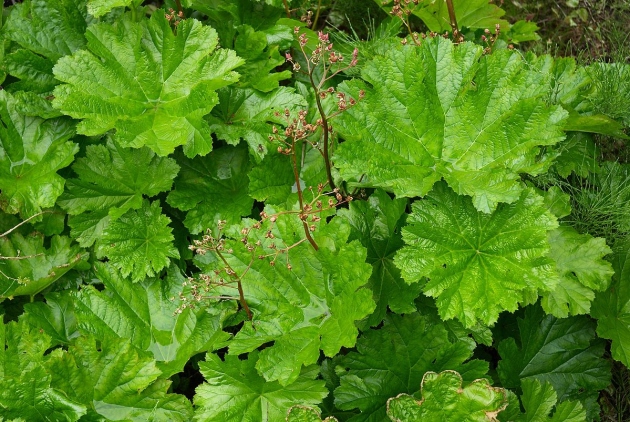
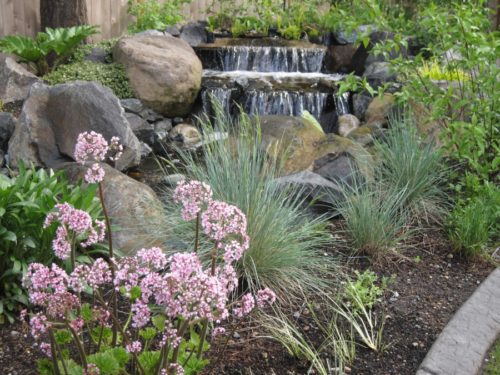
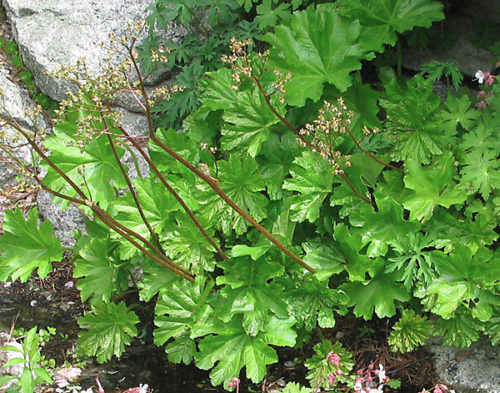
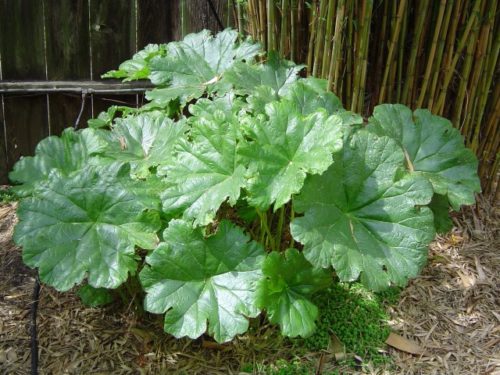
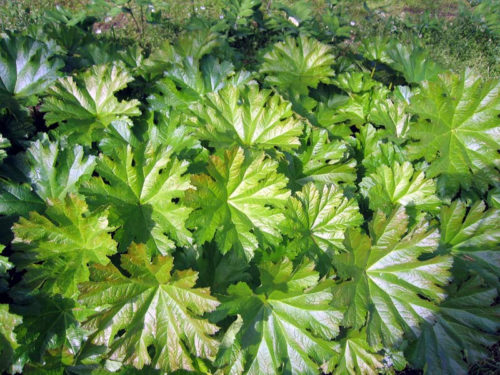
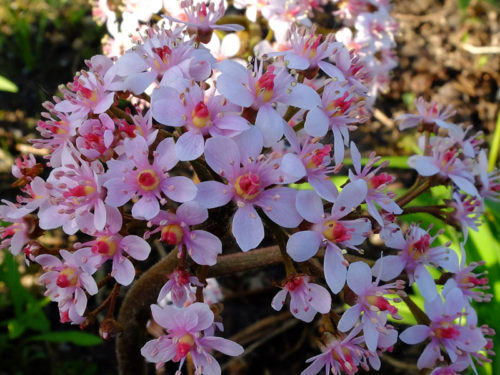
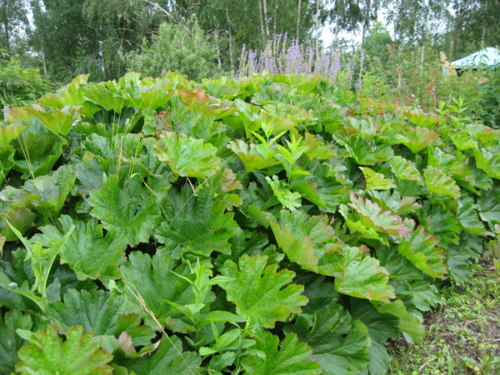
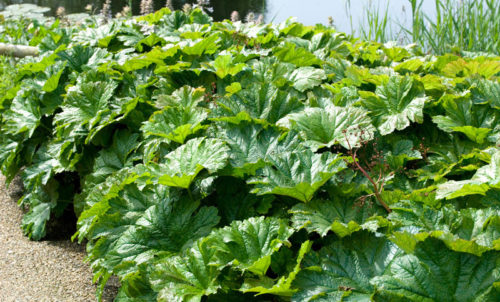
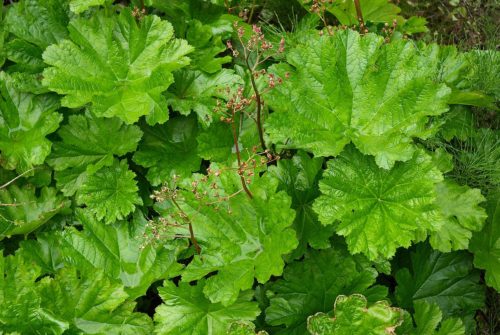
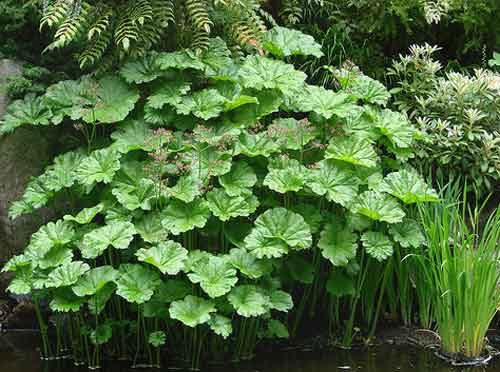












 Start a discussion ...
Start a discussion ...